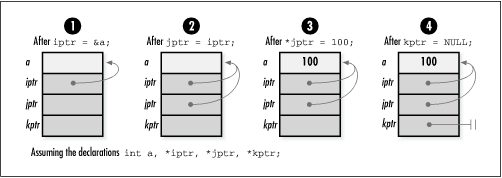Pointer Fundamentals
Recall that a pointer is simply a variable that stores the address where a piece of data resides in memory rather than storing the data itself. That is, pointers contain memory addresses. Even for experienced developers, at times this level of indirection can be a bit difficult to visualize, particularly when dealing with more complicated pointer constructs, such as pointers to other pointers. Thus, one of the best things we can do to understand and communicate information about pointers is to draw diagrams (see Figure 2.1). Rather than listing actual addresses in diagrams, pointers are usually drawn as arrows linking one location to another. When a pointer points to nothing at all—that is, when it is set to NULL—it is illustrated as a line terminated with a double bar (see Figure 2.1, step 4).
As with other types of variables, we should not assume that a pointer points anywhere useful until we explicitly set it. It is also important to remember that nothing prevents a pointer in C from pointing to an invalid address. Pointers that point to invalid addresses are sometimes called dangling pointers. Some examples of programming errors that can lead to dangling pointers include casting arbitrary integers to pointers, adjusting pointers beyond the bounds of arrays, and deallocating storage that one or more pointers still reference.

Get Mastering Algorithms with C now with the O’Reilly learning platform.
O’Reilly members experience books, live events, courses curated by job role, and more from O’Reilly and nearly 200 top publishers.

